What type of headaches do Brits experience the most?
Headaches are very common and can be due to many day-to-day things like dehydration or stress. Feeling unwell with things like a cold or a bug can make us prone to headaches as well.
In our previous screentime study, we revealed there is a link between staring at screens for a prolonged period and health problems such as eye strain and headaches.
While continuous headaches could indicate that you need an updated contact lens or glasses prescription, we know that the cause of headaches is diverse.
Therefore, we wanted to find out more about the most common types of headaches Brits experience, and what their most popular remedies are.
To do this, we surveyed 2,000 UK adults on their experiences with headaches and split the data by industry, gender, age, and region.
Tension headaches and migraines are most common
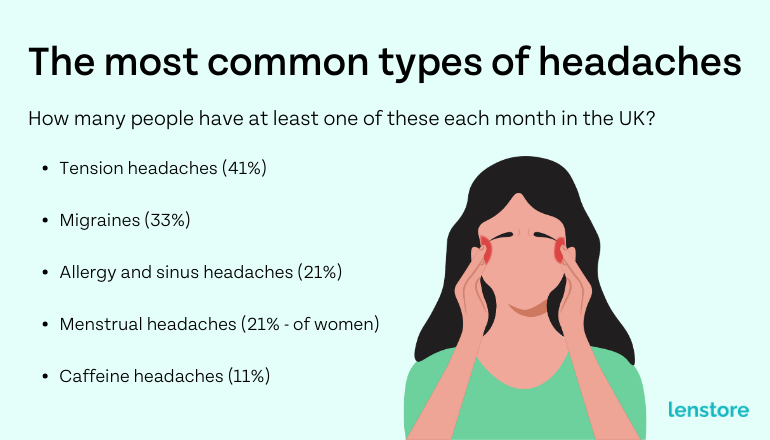
Tension headaches are the most common form of headache with 41% (equivalent to more than 20 million UK adults) saying they have suffered from them in the past month.
Tension headaches are characterised by pain on both sides of the head, face, or neck. It may also feel like something is pressing on your head or being tightened around it, according to NHS advice.
Unfortunately, a third of the population (33%) have been affected by migraines at least once in the last month, which are very bad headaches with throbbing pain on one side of the head.
A further one in five (21%) have also experienced allergy or sinus related headaches.
Most Common Types of Headaches
- Tension headaches (41% have had at least one in the last month) - Pain on both sides of head, face or neck with the feeling someone is constantly pressing on your head
- Migraines (33%) - Intense and long-lasting headache, ability to interrupt day-to-day activities
- Allergy and sinus headaches (21%) - Throbbing head and impacting spaces within your sinuses, including pressure around the eyes, cheeks, and forehead
- Menstrual migraines (21% - of women) - Also known as a hormone headache, starts before or during the menstrual cycle causing a dull throbbing or severe pulsing headache
- Caffeine headaches (11%) - Usually caused by the withdrawal of caffeine but sometimes triggered by excessive intake – pain and pressure that starts behind the eyes and then to the front of the head.
Over a third of respondents (38%) get a headache at least once a week and even more worryingly, 7% (equivalent to 3.4 million of the British adult population) of those say they have headaches every single day.
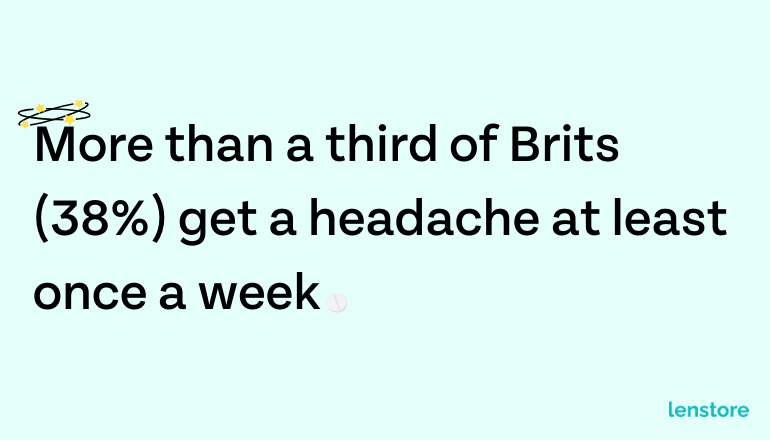
Frequency of headaches for UK adults
- A few times a year: 34%
- Once a month: 19%
- Once a week: 16%
- More than once a week: 15%
- At least once a day: 7%
Painkillers are the preferred treatment
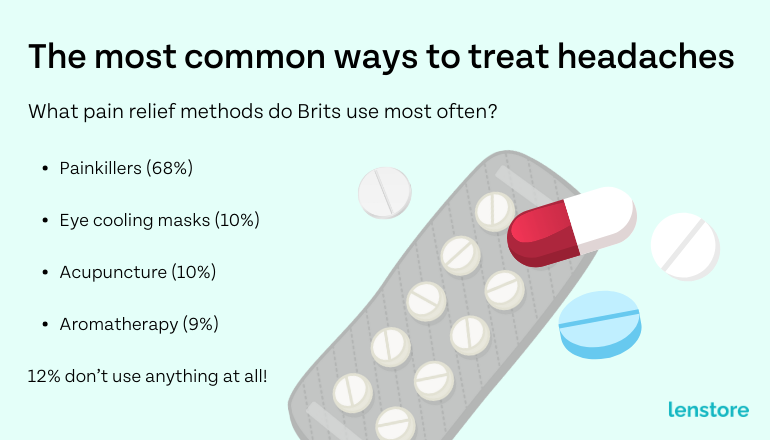
Using painkillers (68%) such as paracetamol seems to be the most common way Brits treat their headaches, according to the data.
However, 12% of the UK population say they don’t do anything at all to ease the pain and instead suffer the side effects of their headaches.
Alternative treatments such as Acupuncture and Aromatherapy are not as widespread as painkillers and have only been tried by 1 in 10 Brits respectively.
Creative industries give their employees the most headaches
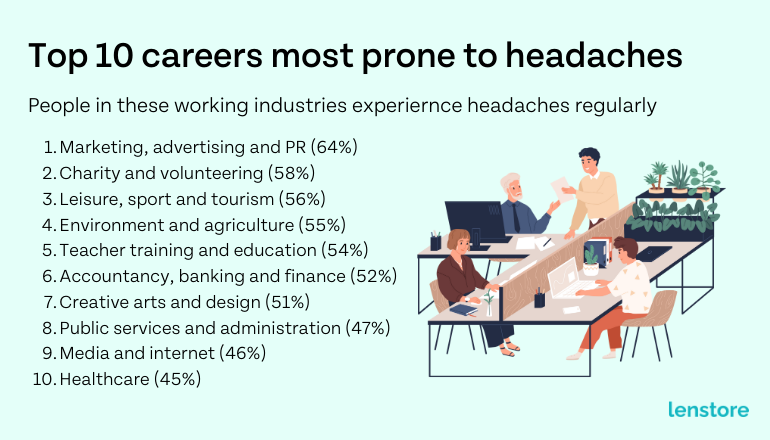
When it comes to different industries, it seems that creative workers are particularly prone to suffer from regular (at least once monthly) headaches.
Marketing, advertising, and PR came on top with nearly two in three workers affected (64%). According to Statista, as of 2022 women made up 58 per cent of the marketing workforce in the UK and men made up 42 per cent.
As creative industries tend to have more female workers, this may explain our later findings on why women tend to be more prone to headaches than men.
In second place, charity and voluntary work was responsible for giving over half its workers headaches (58%). Following closely behind in third place was leisure, sport, and tourism (56%).
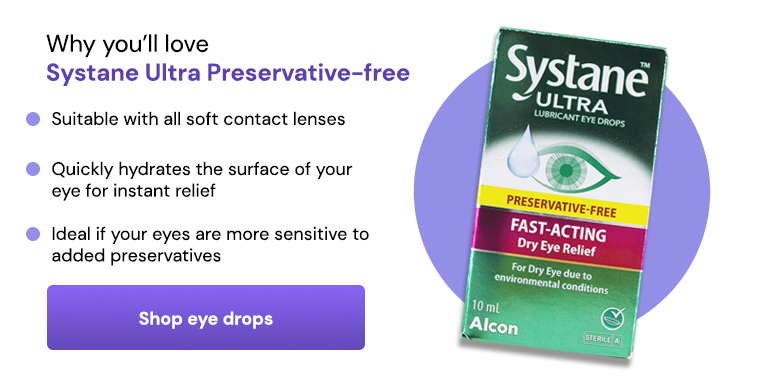
Issues with clients, pressures to perform, long working hours and stressful environments could be to blame for this development across creative industries.
On the other end, those working in property and construction are the least likely to experience headaches (38%), even more so than those who are retired and unemployed (34%).
Women are more prone to headaches than men
Most women (9 in 10) experience regular headaches, whereas one in ten (10%) of men can’t even remember the last time they experienced a headache.
Almost two-fifths of women (39%) suffer from migraine headaches and one in five (21%) from menstrual migraines (also known as hormone headaches).
| Top 10 types of headaches women experience | |
| Reason | % |
| Tension headache | 47% |
| Migraine headache | 39% |
| Allergy or sinus headache | 24% |
| Menstrual migraines | 21% |
| Caffeine headache | 13% |
| Cluster headache | 12% |
| Ice pick headache | 9% |
| Hypertension headache | 8% |
| Exertion headache | 7% |
| Thunderclap headache | 5% |
| Top 10 types of headaches men experience | |
| Reason | % |
| Tension headache | 32% |
| Migraine headache | 25% |
| Allergy or sinus headache | 17% |
| Caffeine headache | 9% |
| Cluster headache | 9% |
| Hypertension headache | 7% |
| Exertion headache | 7% |
| Ice pick headache | 5% |
| Spinal headache | 4% |
| Post-traumatic headache | 4% |
When it comes to treatments, almost three-quarters of women (72%) rely on painkillers. Unlike men, women are willing to try three other methods aside from painkillers before giving up on how to relieve headaches. These include eye-cooling masks (11%), acupuncture (10%), and aromatherapy (9%).
If pain relief is taken more than a couple of days a week, they may trigger headaches themselves.
| Most popular treatment for headaches for women | |
| Painkillers | 72% |
| Eye cooling mask | 11% |
| Acupuncture | 10% |
| Aromatherapy | 9% |
| I don't use anything to treat my headaches | 9% |
| Migraine gel patches | 7% |
| Magnetic headband | 3% |
Almost two thirds of men (61%) will only rely on painkillers to relieve their headaches and not try any other remedy if that doesn’t work. One in six (17%) will avoid using anything and just suffer with a headache.
| Most popular treatment for headaches for men | |
| Painkillers | 61% |
| I don't use anything to treat my headaches | 17% |
| Migraine gel patches | 10% |
| Aromatherapy | 9% |
| Acupuncture | 8% |
| Eye cooling mask | 8% |
| Magnetic headband | 6% |
Frequency of headaches varies with age
The use of painkillers is the most popular between 35–54-year-olds and four in five (80%) within that age group will rely on them to relieve headaches.
Suffering from Menstrual/ hormonal migraines decreases by nearly 25% from the ages of 18 to 34.
However, 22% of 18–24-year-olds have the highest chance of suffering from this kind of headache.
It seems by the age of 65, you are least likely to suffer from headaches with over 40% of recipients claiming they never experience headaches at all.
Likewise, over 34% of retirees claimed they don’t experience any type of headaches, which could be due to the lack of work-related stress.
Where are the UK’s headache Capitals?
To better understand how common certain types of headaches are across the country, we broke down the findings to pinpoint which cities have it the worst.
Bristol suffers from the widest range including tension, ice pick, hypertension, and spinal headaches.
Belfast comes in a close second with the city having to contend with thunderclap headaches, exertion headaches and post-traumatic headaches.
Newcastle also suffers from a range of headaches including menstrual migraines, caffeine headaches, and rebound headaches.
Sheffield was found to be the city most prone to suffering from headaches with more than half of the population experiencing tension headaches (53%).
This was closely followed by Bristol with 52% and Newcastle with 46%
| Headache Capitals | ||
| Headache | City | % |
| Tension headache | Bristol | 52% |
| Cluster headache | London | 14% |
| Migraine headache | Liverpool | 37% |
| Ice pick headache | Bristol | 11% |
| Thunderclap headache | Belfast | 8% |
| Allergy or sinus headache | Sheffield | 28% |
| Menstrual migraine (also known as a hormone headache) | Newcastle | 22% of women |
| Caffeine headache | Newcastle | 15% |
| Exertion headache | Belfast | 13% |
| Hypertension headache | Bristol | 12% |
| Rebound headache | Newcastle | 5% |
| Post-traumatic headache | Belfast | 8% |
| Spinal headache | Bristol | 7% |
The importance of regular eye tests
While the causes of headaches are diverse, eye strain from staring at a screen too long can make you more prone to certain types of headaches.
Last year, we found that the British public spend an average of 13 hours and 2 minutes looking at screens each day, equating to 16 days, 12 hours, and 25 minutes every month and 198 whole days each year.
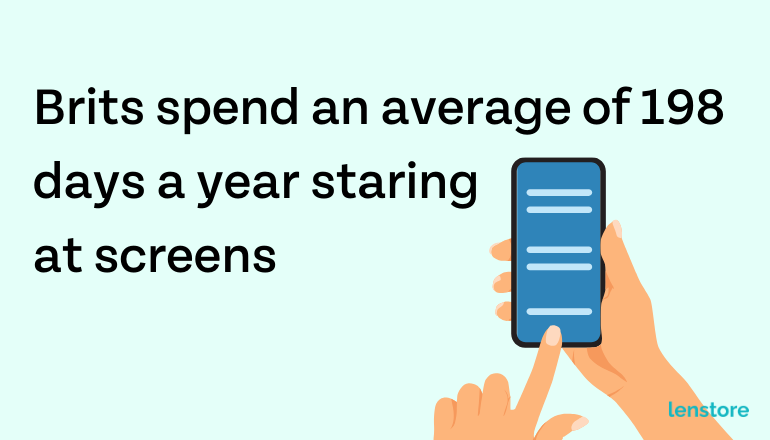
In our previous study, over three quarters of Brits have suffered headaches from staring at a screen, while the majority have felt eye strain from looking at screens for too long (83%).
It is important to take regular breaks off the screen by remembering the 20-20-20 rule. Walking away from the screen and maybe even do some exercises to stretch your muscles can also ease the tension.
Our survey also shows that painkillers are an effective remedy, if taken in moderation. Furthermore, it may be worth trying an eye cooling mask, aromatherapy, or acupuncture (as 1 in 10 Brits have treated headaches like this before)
Regular eye tests (usually every two years, or sooner if you are having symptoms) are the best way to ensure you have the right prescription that fits your needs and keeps your vision sharp, even while looking at screens for a long time.
Luckily, most of the nation seem to follow advice to get an eye test at least once every two years, with over 40% sticking to it according to our newest data. Nearly a quarter of Brits even make sure they get an eye test every year.
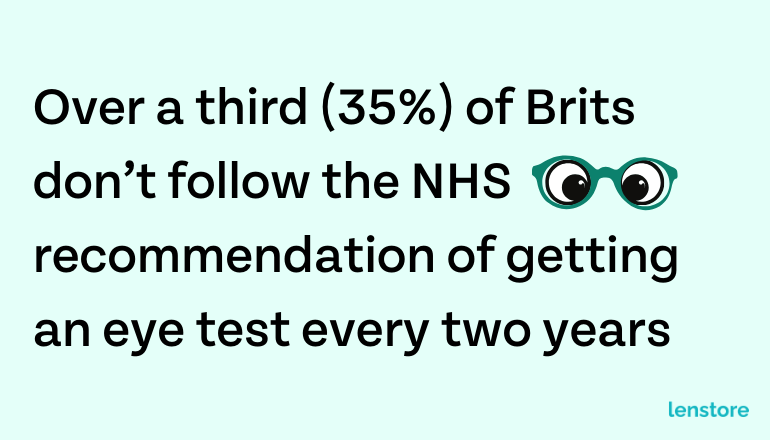
The data shows that over a third (35%) get their eyes tested less often than advised. Furthermore, 16% of us only bother to get their eyes tested every three to four years and 8% say they have never had an eye test before.
Many might not be aware that the NHS offers free eye tests for eligible individuals, so it is worth checking if you qualify.
We have also partnered with Vision Express to provide free eye tests and contact lens aftercare for our customers. If you have shopped with us recently, find out more about this offer here.
Sources & Methodology
- Survey: 2,000 Respondents Aug 2023
- Split by gender, age, industry and city
- https://www.lenstore.co.uk/eyecare/how-long-do-brits-spend-on-their-phones
- https://www.statista.com/statistics/1374855/marketing-professionals-gender-uk/#:~:text=In%202022%2C%20women%20made%20up,belonged%20to%20an%20ethnic%20minority.
- 2021 Census (https://www.gov.uk/government/publications/census-2021-first-results-england-and-wales/population-and-household-estimates-england-and-wales-census-2021#population-sizes-and-changes-for-regions-and-local-authorities):
- The usual resident population of England and Wales was 59,597,300 (59.6 million)
- Adult population = 49.2 million



